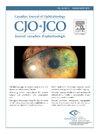使用替普鲁单抗治疗甲状腺眼病后的眼眶减压。
IF 3.3
4区 医学
Q1 OPHTHALMOLOGY
Canadian journal of ophthalmology. Journal canadien d'ophtalmologie
Pub Date : 2025-02-01
DOI:10.1016/j.jcjo.2024.06.003
引用次数: 0
摘要
目的量化一家三级医疗机构眼眶减压手术的减少情况,并确定甲状腺眼病患者接受替普鲁单抗治疗后眼眶减压手术的比例和预测因素:方法:使用Epic的SlicerDicer程序分析眼部整形外科评估的甲状腺眼病(TED)患者总人数的最新趋势,以及CPT代码67445(为减压而进行外侧眶骨切除术)和67414(为减压而进行眶骨切除术)的使用趋势。一家三级医疗中心对接受过替普鲁单抗治疗的活动性中度至重度 TED 患者进行了回顾性病历审查。主要结果指标是患者在接受替普鲁单抗治疗后是否接受了骨性眼眶减压手术。SlicerDicer搜索显示,在临床评估的TED患者人数不断增加的背景下,CPT代码67445和67414的使用率在2016年至2019年期间保持稳定,随后在2020年至2023年期间显著下降。泰泊单抗治疗后,25%的患者和18%的眼眶接受了骨减压。与未接受骨减压的患者相比,接受手术减压的患者在接受替普鲁单抗治疗前后的眼球外径测量值更高。泰泊单抗治疗结束或停止后的平均减压时间为12.6个月:结论:近年来,在一家三级医疗中心接受治疗的 TED 患者人数有所增加,但眼眶减压手术的数量却有所下降。结论:近年来,虽然一家三级医疗中心治疗的 TED 患者人数有所增加,但眼眶减压手术的数量却有所下降。然而,在使用替普鲁单抗治疗后,仍有部分患者需要进行眼眶减压手术。本文章由计算机程序翻译,如有差异,请以英文原文为准。
Orbital decompression following treatment with teprotumumab for thyroid eye disease
Objective
To quantify the observed decrease in orbital decompressions being performed at one tertiary care institution and to determine the rate and predictive factors of orbital decompression surgery following treatment with teprotumumab for thyroid eye disease.
Methods
Epic's SlicerDicer program was used to analyze recent trends in the overall number of thyroid eye disease (TED) patients evaluated in the oculoplastic surgery department, as well as usage trends of CPT codes 67445 (lateral orbitotomy with bone removal for decompression) and 67414 (orbitotomy with removal of bone for decompression). A retrospective chart review of active moderate-to-severe TED patients treated with teprotumumab was performed at a single tertiary care center. The main outcome measure was whether or not patients underwent bony orbital decompression surgery following treatment with teprotumumab. The SlicerDicer search demonstrated stable usage of CPT codes 67445 and 67414 from 2016 to 2019, followed by a significant decrease from 2020 to 2023, over a background of increasing numbers of TED patients evaluated in clinic. Following teprotumumab therapy, 25% of patients and 18% of orbits underwent bony decompression. Surgically decompressed patients had higher pre- and post-teprotumumab exophthalmometry measurements compared with patients who did not undergo bony decompression. Average time to decompression following conclusion or cessation of teprotumumab therapy was 12.6 months.
Conclusion
While the number of TED patients treated at one tertiary care center has risen over recent years, the number of orbital decompression surgeries has declined. Orbital decompression, however, is still needed in select patients after treatment with teprotumumab.
Objectif
Quantifier la baisse observée du nombre de décompressions orbitaires réalisées dans un établissement de soins tertiaires, calculer le taux de ce type de chirurgie après l'administration de téprotumumab dans le traitement de l'ophtalmopathie thyroïdienne (OT) et faire ressortir les facteurs de prédiction à cet égard.
Méthodes
Le programme SlicerDicer d'Epic a servi à analyser les tendances récentes quant au nombre global de patients présentant une OT qui ont été évalués au service de chirurgie oculoplastique de même que les tendances en matière d'utilisation des codes d'identification 67445 (orbitotomie latérale comprenant une résection osseuse afin de réaliser une décompression) et 67414 (orbitotomie comprenant une résection osseuse afin de réaliser une décompression) selon la Current Procedural Terminology (CPT). Un examen rétrospectif des dossiers médicaux de patients présentant une OT évolutive modérée à grave et qui ont reçu le téprotumumab a eu lieu dans un établissement de soins tertiaires unique. Le principal paramètre de mesure reposait sur la réalisation – ou non – d'une chirurgie de décompression orbitaire après un traitement par le téprotumumab. La recherche dans le programme SlicerDicer a mis au jour une utilisation stable des codes 67445 et 67414 selon la CPT de 2016 à 2019, suivie d'une baisse significative de 2020 à 2023, dans un contexte où il se produit une hausse des patients évalués à la clinique en raison d'une OT. Après l'administration de téprotumumab, 25 % des patients et 18 % des orbites ont subi une décompression osseuse. Les mesures obtenues à l'exophtalmométrie chez les patients qui ont subi une chirurgie de décompression étaient plus élevées, tant avant qu'après la prise de téprotumumab, comparativement aux patients qui n'ont pas subi de chirurgie de décompression osseuse. Il s'est écoulé en moyenne 12,6 mois avant la décompression après la fin ou l'interruption de l'administration de téprotumumab.
Conclusion
Si le nombre de patients traités en raison d'une OT dans un centre de soins tertiaires a augmenté au cours des dernières années, le nombre de chirurgies de décompression orbitaire, pour sa part, a diminué. Cela dit, la chirurgie de décompression orbitaire demeure parfois nécessaire chez certains patients après l'administration de téprotumumab.
求助全文
通过发布文献求助,成功后即可免费获取论文全文。
去求助
来源期刊
CiteScore
3.20
自引率
4.80%
发文量
223
审稿时长
38 days
期刊介绍:
Official journal of the Canadian Ophthalmological Society.
The Canadian Journal of Ophthalmology (CJO) is the official journal of the Canadian Ophthalmological Society and is committed to timely publication of original, peer-reviewed ophthalmology and vision science articles.

 求助内容:
求助内容: 应助结果提醒方式:
应助结果提醒方式:


